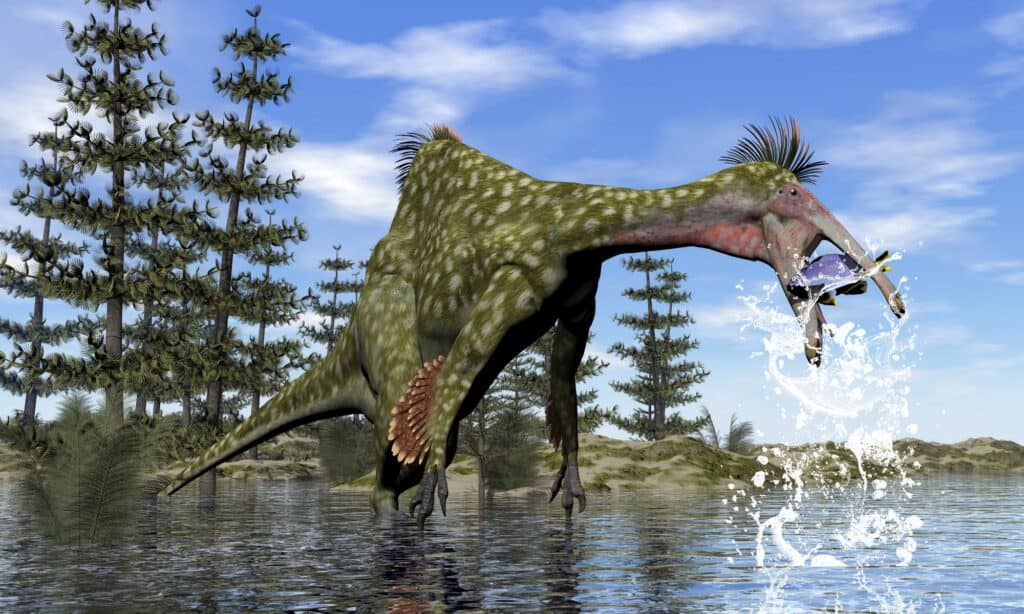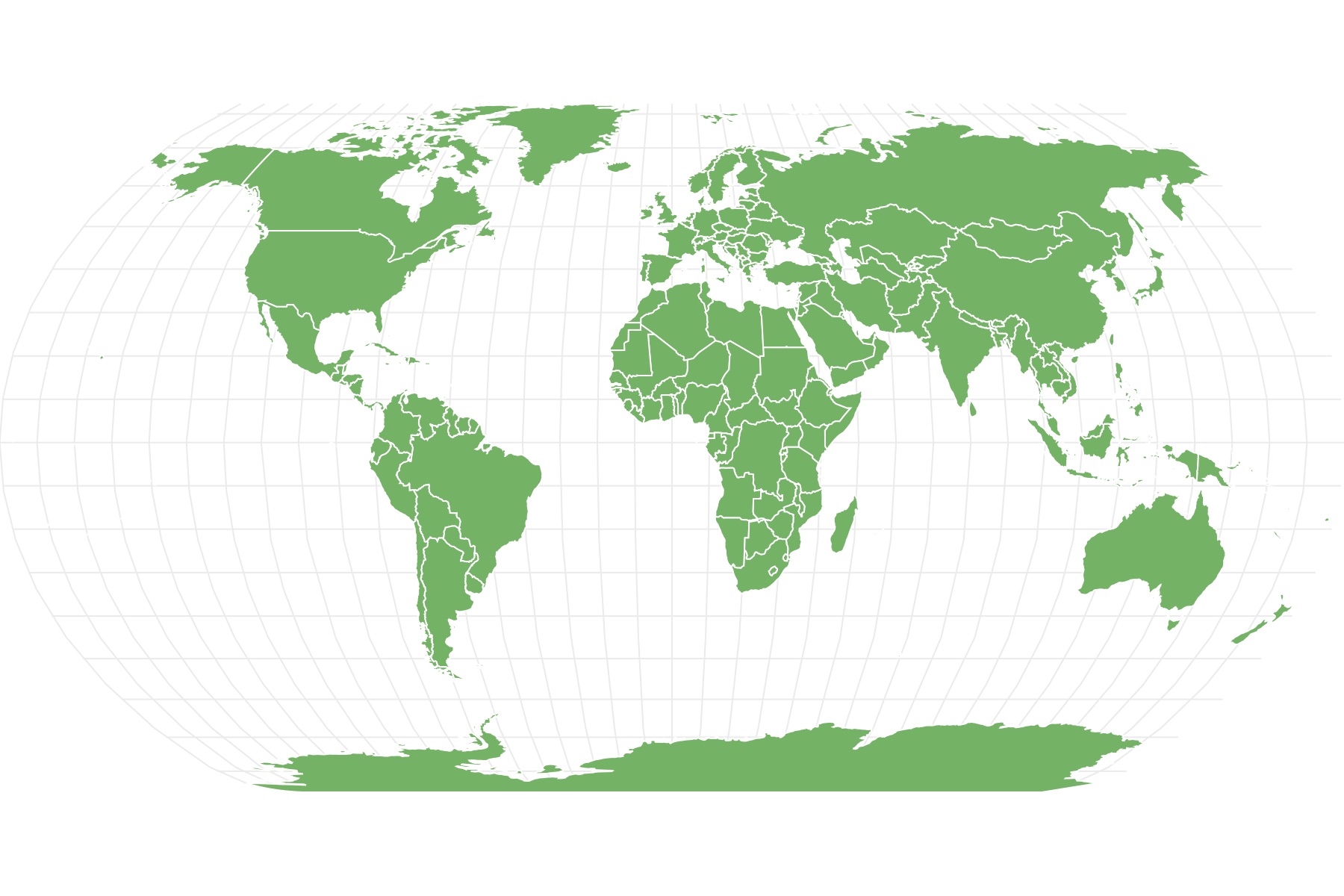Deinocheirus
Deinocheirus mirificus
Despite being bipedal, Deinocheirus had a large forearm
Advertisement
Deinocheirus Scientific Classification
- Kingdom
- Animalia
- Phylum
- Chordata
- Family
- Deinocheiridae
- Genus
- Deinocheirus
- Scientific Name
- Deinocheirus mirificus
Read our Complete Guide to Classification of Animals.
Deinocheirus Conservation Status
Deinocheirus Facts
- Prey
- Fish
- Fun Fact
- Despite being bipedal, Deinocheirus had a large forearm
- Most Distinctive Feature
- Deinocheirus had giant sails on its back
- Distinctive Feature
- Deinocheirus had long forelimbs
- Habitat
- Shallow lakes, mudflats, streams, and river channels
View all of the Deinocheirus images!
Deinocheirus was a bizarre dinosaur that lived in Asia during the Late Cretaceous around 70 million years ago. For up to 50 years after its first discovery, scientists struggled to determine its appearance or habits. You can compare this dinosaur to a giant goose because of its beaked head, a camel because of its hump, and an ostrich because of its legs. However, we now know more about this unusual ornithomimosaur thanks to more recent fossil discoveries.
Description and Size

Deinocheirus dinosaur fishing in a lake. It is thought that the Deinocheirus was omnivorous, eating both small animals and plants.
©iStock.com/Elenarts108
Deinocheirus was a large ornithomimosaur that lived around 70 million years ago during the Late Cretaceous. The only species of this dinosaur found so far is the Deinocheirus mirificus.
The genus name translates as “horrible hand,” in Greek, a reference to the most well-preserved part of the dinosaur—its forelimbs. This was the part of the dinosaur that paleontologists found first, measuring up to eight feet long. This includes a 34.9 inches long humerus, a 27.1-inch long ulna, and claws measuring up to 7.7 inches.
An adult Deinocheirus weighed 14,330 pounds and stood at 16 feet. The entire body measured up to 36 feet in length. Unlike other bipedal dinosaurs that tend to have relatively small arm, this dinosaur’s arms was quite large with blunt claws on its three fingernails. Its legs also bore short, blunt claws, and it had tall neural spines forming a sail along its back. The skull of the Deinocheirus was about 3.36 feet wide.
Deinocheirus was a bulky dinosaur. However, it had hollow bones, which made the dinosaur lightweight. It had tall and relatively straight dorsal ribs. Deinocheirus also had an S-curved neck. The curvature of this dinosaur’s neck was more than that of other ornithomimosaurs . The skull was long, narrow, and tall, with a wide bill at the end. The jaws bore a beak instead of teeth, and the dinosaur’s leg did little running.
The sail-back consisted of long spines on its vertebrae, forming a point over the middle. This gave it the appearance of a massive hump-back. Like other ornithomimosaurs, the Deinocheirus was likely feathered too. The tail ended in pygostyle-like vertebrae, indicating a possible presence of a fan of feathers.
Diet—What Did Deinocheirus Eat?
Unlike other ornithomimosaurs, Deinocheirus was an omnivore. The dinosaur had a beak similar to a duck’s, which indicates it foraged in water or near the ground, like hadrosaurs and sauropods. Also, based on observations of the jaw muscles of this dinosaur, scientists concluded that Deinocheirus had a weak bite force. It also had a large tongue for sucking in food material. Therefore, the dinosaur is likely more adapted to feeding on soft vegetation near water bodies or in the forest understory.
Scientists found more than 1,400 stomach stones measuring 0.31–3.4 inches in the stomach of one Deinocheirus specimen. Like birds today, there are theories that these stomach stones helped the toothless Deinocheirus grind its food. However, scientists also found fish vertebrae and scales among the gastroliths, which suggests Deinocheirus was an omnivore.
Habitat—When and Where Did Deinocheirus Live?
The three known Deinocheirus specimens recovered were from the Nemegt Formation in the Gobi Desert of Southern Mongolia. Scientists believe Deinocheirus was widely distributed within the Formation, as the three known specimens were found 50 kilometers apart. The Deinocheirus probably lived at the end of the Late Cretaceous Period, during the Early Maastrichtian Stage, some 70 million years ago. The area where the fossils were recovered probably had shallow lakes, mudflats, streams, and river channels that may have experienced periodic droughts.
Deinocheirus—Threats and Predators
Deinocheirus was a giant that stood equal to the tyrannosaurs in size. Healthy adults had long-clawed arms, and their large size showed they were no pushovers. As a result, the only possible predators of Deinocheirus were other massive dinosaurs. Predatory theropods that shared habitats with Deinocheirus include tyrannosaurids like Alioramus and Tarbosaurus and troodontids like Tochisaurus and Borogovia.
Discoveries and Fossils
Polish paleontologist, Zofia Kielan-Jaworowska, discovered the first known fossil remains of Deinocheirus. She discovered the remains on July 9, 1965, as a part of a group expedition that included the Mongolian paleontologist Rinchen Barsbold. The first fossil of this dinosaur was found in the Nemegt Basin of the Gobi Desert. The expedition team discovered the specimen buried in sandstone on a small hill. It consisted of two forelimbs with the claws missing one of them. The find also included three dorsal vertebrae, a complete shoulder girdle, 5 ribs, and some internal organs. The never-seen-before arms earned the fossil its name. However, until 40 years after its discovery, scientists could not identify the rest of the mysterious dinosaur.
In 2006, scientists discovered new fossil fragments from the original fossil site where the Deinocheirus was first found. The new elements were fragments of gastralia with bite marks on them. Scientists identified the bite marks to be of a Tarbosaurus. This shows that the original fossil was probably a victim of a Tarbosaurus attack. This explains the fragmented nature and poorly preserved state of the bones.
By 2013, Lee, Barsbold, Currie, and colleagues announced two new Deinocheirus specimens before the annual conference by the Society of Vertebrate Paleontology. One of the specimens was found by Altan Ula IV during the 2006 expeditions but had already been damaged by fossil poachers. Buglin Tsav found the second specimen in 2009. Like the former, it had also been excavated by poachers, who had removed the skull, hands, and feet but left behind a single toe bone. On May 1, 2014, the Belgian Museum repatriated the stolen bones to Mongolia. The discovery of these new fossils shed some more light into the half-a-century-old mystery of the Deinocheirus.
Extinction—When Did Deinocheirus Die Out?
Deinocheirus died out approximately 66 million years ago during the K-T extinction event. This was a mass extinction event that wiped out more than 90% of the non-avian dinosaurs still living at the end of the Cretaceous. Scientists believe that this event was caused by a major catastrophic event that had planet-wide effects such as massive asteroid impact or volcanic activity.
Similar Animals to the Deinocheirus
Similar Animals to Deinocheirus include:
- Hadrosaurs — The hadrosaurs are also called duck-billed dinosaurs because of the flat duck-bill appearance of the bones in their snouts. The dinosaur was among the most dominant herbivores of the Late Cretaceous Period, found in Europe, Antarctica, Africa, and South America.
- Gallimimus — Gallimimus was a mid-sized theropod dinosaur that lived in Mongolia during the late Cretaceous period. Several fossils were discovered in the Gobi Desert during the 1960s, and the dinosaur shared a habitat with the Deinocheirus.
- Tyrannosaurus rex — The T. rex is one of the best-represented theropods ever found, as it has a wider range than other tyrannosaurids. It is one of the largest known land predators, and scientists believe it exerts the strongest bite force among all terrestrial animals.
Related Animals
View all 110 animals that start with DDeinocheirus FAQs (Frequently Asked Questions)
When was the Deinocheirus alive?
Deinocheirus was alive 70 million years ago, during the Early Maastrichtian and Late Cretaceous periods.
How big was the Deinocheirus?
Deinocheirus was as big as the famous Tyrannosaurus rex. The dinosaur weighed 14,330 pounds, stood up to 16 feet, and measured 36 feet in length.
Why did Deinocheirus have a hump?
The hump on the Deinocheirus was thicker than a sail but not as thick as a camel’s hump. It was made up of ligaments like a suspension bridge that helps it balance and support its huge mass on its hindlimbs.
Thank you for reading! Have some feedback for us? Contact the AZ Animals editorial team.
Sources
- Wikipedia, Available here: https://en.wikipedia.org/wiki/Deinocheirus
- National Geographic, Available here: https://www.nationalgeographic.com/science/article/deinocheirus-exposed-meet-the-body-behind-the-terrible-hand
- Earth Archives, Available here: https://eartharchives.org/articles/deinocheirus-the-giant-hunchbacked-dinosaur-with-terrifying-hands/index.html
- Dinopedia, Available here: https://dinopedia.fandom.com/wiki/Deinocheirus

















